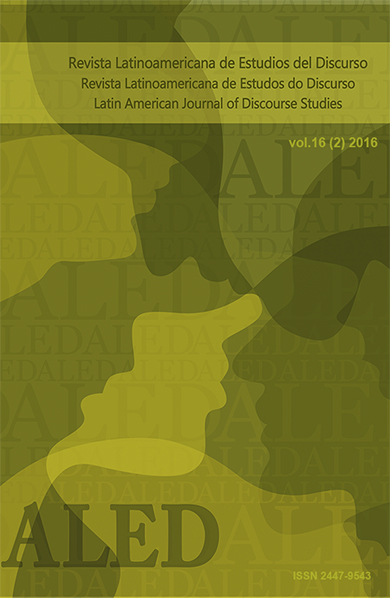El tarot como discurso de contestación en la caricaturista venezolana Rayma
Keywords:
critical discourse analysis. multimodal discourse. editorial humor. discourse of contestation. tarot. RAYMA.Abstract
The attack on the Charlie Hebdo office in Paris by two armed religious fanatics on January 07, 2015 that left eleven people dead and several others injured ”“most of them cartoonists and journalists”“ reminds us that nothing is “more devastating than humor”. Using as theoretical frame a combined approach from critical discourse analysis (Fairclough 1995, 2001, van Dijk 2000, 2011), the study of multimodal discourse (Kress and van Leeuwen 2001, 2006), and from linguistic theories of humor (Attardo 1994, Ruiz Gurillo 2012), I analyze 27 political cartoons entitled “Rayma en Tarot …” [Rayma in Tarot..] published between May 2nd and 30th 2014 in El Universal, a major Venezuelan newspaper. These pieces appeared in a moment of intense protests by university students and the equally intense repression of those protests by President Nicolás Maduro’s government. The inherently connotative genre of the caricature reaches new dimensions when its author assumes the identity of the necromancer and her discourse the divinatory function of tarot. To this end, the author uses characters taken from this age-old art and adapts them to her vignettes; as such, their interpretation will require a special hermeneutic that resides in the revelatory relationship reader-country. The results of this analysis will shed light on the characteristics and function of contestation in editorial humor.
Downloads
References
Adam, J.M. y Bonhomme, M. 1997. L´argumentation publicitaire. Rhétorique de l´éloge et de la persuasión. Paris: Nathan Université.
Attardo, S. 1994. Linguistic theories of humor. Berlin-New York: Mouton de Gruyter.
Charaudeau, P. (ed.) 2015. Humour et engagement politique. Condé-Sur-Noireau, France: Lambert-Lucas.
Cohn, N. 2013. The visual language of comics. London: Bloomsbury.
Crawford, M. 2003. Gender and humor in social context. Journal of Pragmatics 35: 1413-1430.
Fairclough, N. 1995. Critical discourse analysis: The critical study of language. Harlow, England: Longman.
Fairclough, N. 2001. Language and power. Harlow, England: Longman.
Figueras, C. 2013. La construcción de identidades en narrativas multimodales de trastornos de la conducta alimentaria. Discurso y sociedad. 7, 1: 148-199.
Freud, S. 1905. El chiste y su relación con lo inconsciente. (versión Kindle)
Johnstone, B. 2008. Discourse analysis. Victoria, Australia: Blackwell.
Kress, G. y van Leeuwen, T. 2001. Multimodal discourse. The modes and media of contemporary communication. London: Hodder Education.
Kress, G.R. y van Leeuwen, T. 2006. Reading images: The grammar of graphic design (2a ed,). London: Routledge.
Paz, Y. 2014. El Presidente está enfermo ¿Qué tendrá el Presidente?: La enfermedad y sus metáforas en el discurso de Hugo Chávez Frías. Discurso y sociedad. 8, 2: 299 325.
Ruiz Gurillo, L. 2012. La lingüística del humor en español. Madrid: Arco/Libros.
Steeves, J. B. 2004. Imaging bodies: Merleau-Ponty’s philosophy of imagination. Pittsburg, Pennsylvania: Duquesne UP.
Suprani, R. (2015). Drawing a line (Oslo Freedom Forum) https:// www.youtube.com/watch?v=_hzWyk5Lhz4&ebc=ANyPxKqrgbz8fIekErcjPQVXHeTiFERWM-8XVMwClwoA_dbsJ4byax-PzMZI37ZUDpE6TpELq69apGmKLUGy52fbRafOu_GNw Consulta 3/17/2016.
Valloatto, S. 2015. Caricaturistas, soldados de la democracia https://www.youtube.com/watch?v=I5ql3vNprVc https://www.youtube.com/watch?v=9d_oFrwgzRc Consulta 3/19/2016.
van Dijk, T. (ed.) 2000. Discourse as social interaction. London: Sage.
van Dijk, T. 2011. Ideología y discurso. Barcelona: Ariel Lingüística.
Vieira, L. D. 2007. Humor en editoriales de TalCual. Texto e imagen en el discurso político. Revista Latinoamericana de Estudios del Discurso (ALED) 7, 1: 95-114.
Vivero García, M. D. y del Río Barredo, M. J. 2015. La caricature dans les cultures française et espagnole. Quand les dessinateurs prennent position contre les élites. En Patrick Charaudeau (ed.) Humour et engagement politique, pp. 69-86. Condé-Sur-Noireau, France: Lambert-Lucas.
Weber, M. 2003. Le savant el le politique. Paris: La Découverte.
Downloads
Published
How to Cite
Issue
Section
License

This work is licensed under a Creative Commons Attribution-NonCommercial-NoDerivatives 4.0 International License.
The authors retain the copyright and guarantee RALED the right to be the first publication of the work as well as a Creative Commons Attribution License that allows others to share the work with recognition of authorship and the initial publication in this journal.




